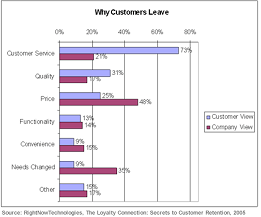This is a guest post by Adrian Swinscoe regarding a very important topic for a small business owner and entrepreneur… customer retention!
Most conversations about business growth would have acquiring new customers right at the top of their list of things to do. For most established businesses, I think that’s rubbish!
I would argue that the most important thing for any established business or brand is to keep hold of their existing customers because what is the point of acquiring more customers if you can’t hold onto your existing ones. Also, what is the cost to your brand of all of those defecting customers?
In a world of increasing competition and ease of defection to other products and services, building and focusing on keeping your customers for longer can be a significant way to grow your business. For example, according to Customer Value Management expert Graham Hill, loss of customers per year for mobile telecommunications companies in the UK averages between 25 and 35%.
One of the biggest losers of customers and worst at retaining its customers is T-Mobile, with a 34.8% churn rate per year, whilst Virgin Mobile is the best performer with only about 14% of its customers leaving annually. Hill says the cost to replace these departing customers could be as high as €122 million or about $155 million per year.
Further, according to Frederick Reichheld of Bain & Company:
- Businesses in many industries may lose up to 50% of their customers over a five year period.
- Studies have shown it is 6 to 7 times more expensive to acquire a new customer than it is to retain a current customer; and
- As little as a 5% increase in customer retention can increase profits by 25 to 95%.
Despite these figures, many businesses still focus on acquiring customers as their primary growth strategy rather than protecting and nurturing what they have.
Why do customers leave?
Before we can start keeping our customers, we first have to try and understand why customers leave. According to work done at the American Society of Quality Control, the main reasons customers leave or stop doing business or a brand are:
- 1% die
- 3% move to another area
- 5% are influenced by friends or contacts to go elsewhere
- 9% are lured away by your competition
- 14% don’t stay because they are disappointed with your product or service; and
- 68% because of your indifferent attitude to them
Further, research by RightNow Technologies (see graphic below) showed that there is a marked difference between the reasons that companies think customers leave and what their customers actually think.
If these findings are true then they have huge implications for business.
They suggest that loss of customers is not about how good your product or service is or how competitive your industry is but rather it’s more about:
- How you are with your customers; and
- How much you care about your customers.
This reminds of a personal example from not so long ago of how my bank lost my custom because they were, I thought, insensitive to the situation we were in and my needs. This happened just after the big financial crisis when most the banks on our high street where in question, in terms of whether they would survive or not. My bank was one of those in question.
I heard nothing from them during the crisis and the first call I got from them after things had started to stabilise was to try and sell me some insurance. Not a call to say ‘Hey, we’re ok. You’re money is ok and how can we help’. I don’t think that would have been unreasonable. Do you? I think that would’ve been nice and would have made me feel like a valued customer.
But, no, a call to sell me something. At that point, I wasn’t sure how long they’d be around and in what form. So, why would I ever buy insurance from them? Now, I have an indifferent impression of them and have moved much of my banking as a result.
I think the implications of all of this falls into a few areas that firms need to focus on:
- It’s not about you (the business), it’s about the customer
- Customer service/care involves everyone in your business not just your customer-service people
- Your relationship with your customers. This may take some time, effort and a lot of trust of your front-line staff because everyone is different and technology and systems are not always the best way to solve a problem. Sometimes its about just being a bit more human, taking a bit more time and a longer view of the relationship you have with the customer.
Want to improve your retention of customers? Here’s a few steps to help you get started:
Get to Know Your Customers
This is not just about how old or how much money they make…get to know them, find out what they like, what they don’t like, ask for their opinion on how you could be better…..
Find Similarities Between Different Customers and Put Them Into Groups to Make Things Easier
Segmenting your customers into different groups will make your life easier and allow you to track retention progress in each group.
Create Specific Content, an Approach to Meet Your Customers Needs
We’re all different and have different preferences. So, be careful to assume that everyone likes a broadcast update email or that everyone is happy to deal with someone on the phone rather than face to face.
Choose Which Customers Are Going to Work For Your Business
This is where reality and tough choices kick in. Not all customers are going to be a good fit for your business so choose which customers will work and be very clear about which ones will not. If you can spot the customer that you know will be disappointed with your customer experience as it does not fit with their needs or requirements and you choose not to do business with them (in the nicest possible way) then you will have saved yourself a lot of time and energy and brand equity in the process. They’ll appreciate the honesty. Refer them onto someone who will be able to fill their needs and you’ll create an advocate for your business without them having spent any money with you.
Develop a Memory
Unless, you are Kim Peek, the 56-year-old savant who inspired the movie Rain Man, then you’re going to need to have a way of gathering and storing the information you have about the relationship with your customer. This is where Customer Relationship Management (CRM) technology can lend a hand. Talk to an expert about this but don’t be led by the technology. Let your customers lead.
Measuring your Progress and Success
Set targets, monitor and measure how you get on. It’s the only way that you will improve. However, realise that improvement can take time and will depend on the nature of your business and current relationships with your customers.
The Results of Improving Your Retention
Now, this is not easy and takes time. But, here’s what happens when you put all of this into place:
- More business – Listening. learning and paying attention will get better response rates from your customers = more business
- Increased customer loyalty – Once you establish a learning relationship with your customers, you can develop a partner-like relationship. Once at that stage, you’ll be able to meet and exceed their expectations by anticipating their needs. The deeper the relationship and more complex their needs, the more they will appreciate your relationship with them and the less likely they will be to move their business elsewhere.
Why wouldn’t you do it? So, who’s for ditching their outbound marketing budget and focusing on their existing customers?


